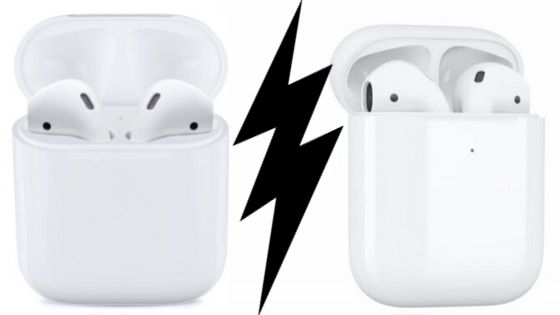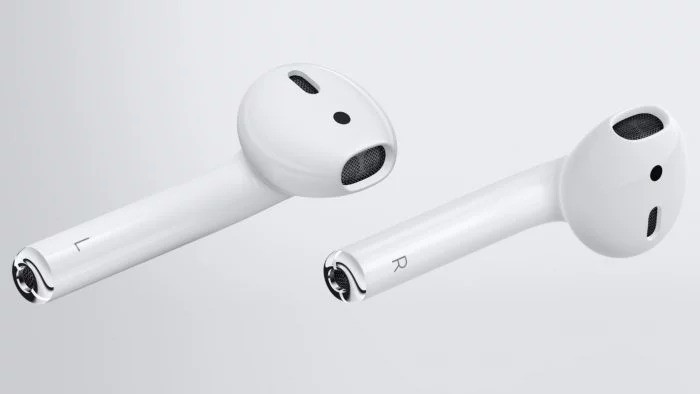Apple launched its first AirPods in 2016. The first generation of wireless headsets reinvented listening, making calls, watching movies, playing games and interacting with Siri. Criticized for their look – which just seems to have cut the cables from the original headphones – they came in a case that also serves to recharge and are always ready to use. In 2019, however, came the AirPods 2 and also the AirPods Pro (the third version, noise canceling).
Today we will not talk about AirPods Pro, but the differences between the first and second generation of AirPods. What changes? Is it still worth buying the AirPods 1? Read on.

The AirPods First Generation
In AirPods 1, its main innovation was being able to just put the earbuds to the ear that the sound would start playing automatically (and stop when you take it off). To adjust volume, change music, make calls or search itineraries, Siri is activated with two taps.
AirPods 1 come with dual microphones; two optical sensors; motion detection accelerometer and voice detection accelerometer. All of this is designed to work with the Apple-developed W1 chip, which knows if you are using one or both headphones, directing the sound and activating the microphone automatically.
If you’re on a call or talking to Siri, one of the accelerometers activates the spatially filtered dual microphones to counteract background noise and focus only on your voice. With an autonomy of 5 hours of music on one charge and 24 hours (listening only) with the extra charges on the case, it also lets you use a quick 15-minute recharge that guarantees up to three hours of sound.
AirPods 1 work with Apple devices with software running iOS 10, watchOS 3, or macOS Sierra versions. For compatible devices, see the tables at the end.
The AirPods 2
As a new feature, AirPods 2 brought new controls to Siri. Just double-tap to play, change music, or answer a call and say “Hey, Siri” to play a song, make a call, or get an itinerary from Apple Maps.
The new H1 chip has improved performance, and now the headphones offer 50% more talk time and the induction-powered case option (Qi standard). This created 2 purchase options: with or without the wireless charging case.

The LED light on the case conveniently shows charge status and those who already had AirPods 1 can buy the case wirelessly separately. AirPods 2 also comes at twice the connection speed, and you can switch handsets seamlessly when listening to music on iPhone, Apple Watch, or iPad.
Let’s put this data side by side?
AirPods 1 vs AirPods 2
| AirPods 1 | AirPods 2 | |
| Ear Adjustment | Universal (no adjustment). | Universal (no adjustment). |
| Noise Canceling | Not | Not |
| Chip | W1 | H1 |
| What’s up Siri? | Two-touch access. | By voice and always on. |
| Sweat and water resistant | Not | Not |
| Battery Life Audio / Charge Time | Up to five hours of sound Up to two hours of talk time. | Up to five hours of sound Up to three hours of talk time. |
| Additional battery life with case | More than 24 hours of sound Up to 11 hours of talk time. | More than 24 hours of sound Up to 18 hours of talk time. |
| Wireless case | No. Lightning / USB cable. | Yes. With Qi standard and / or Lightning connector. |
| Weight (each) | 4 g (0.14 ounces) | 4 g (0.14 ounces) |
| Weight (case) | 38 g (1.34 ounces) | 40g (1.41 ounces) |
| Size (each) | 16.5 x 18 x 40.5 mm | 16.5 x 18 x 40.5 mm |
| Size (case) | 44.3 x 21.3 x 53.5 mm | 44.3 x 21.3 x 53.5 mm |
| Bluetooth 5.0 | Yes | Yes |
Is First Generation Airpods still worth buying?
If you find AirPods 1 out there, it might be a good deal if it’s much lower than the original wired case model that costs $159 on the Apple website. This model dropped to around $79 after AirPods 2.
For those who use Siri a lot and want to be up to date, moving to AirPods 2, therefore, is certainly the best option. And if you don’t want to spend the full amount of the new AirPod (2019), you can choose to buy only the wireless case. There are some compatible (non-Apple) cases on the market at cheaper prices here.
Is your iPhone, iPad, or Apple Watch old?
Before you buy, check AirPods for compatibility with your devices.
AirPods 1 and AirPods 2 compatibility
Can I use on Android?
Can! AirPods can be used as Bluetooth headsets on both Apple devices with earlier software versions (not listed) and non-Apple devices, but some features will be limited.
The most obvious is Siri. However, because the phones are designed with chips specific to updated Apple devices, features may not run.
| AirPods 1 | AirPods 2 | |
| System Requirements |
|
|
| IPhone models |
|
|
| IPad templates |
|
|
| Mac models |
|
|
| Watch Models |
|
|
| Apple TV models |
|
|
| IPod models |
|
|